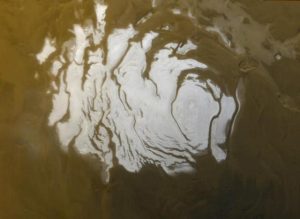Mars has long been thought of as dry and barren – unable to harbour life. But research over the past few years indicates that there is most likely some briny water present there today, including a possible subsurface lake. This has led to new hopes that there could actually be life on the red planet after all, depending on what the conditions are like in the water.
Now, a new study, published in Nature Geoscience, surprisingly shows that brine deposits below the surface of Mars, particularly near the poles, can contain molecular oxygen – which is crucial for life on Earth. This is exciting as it makes it even more likely that the planet could support microbial life or even simple animals like sponges.

The surface of Mars 3.8 billion to 4 billion years ago was much like the Earth’s and would therefore have had the right conditions for life. At that time, it had a thick atmosphere and flowing water on the surface, a global magnetic field and volcanism.
Today, the surface is dry and cold – 5ºC to 10ºC by day and -100ºC to -120ºC at night. In fact, the atmospheric pressure now is less than 1% of the Earth’s, meaning that any flowing water would quickly evaporate into the atmosphere. But it can remain trapped below the surface. Volcanism is also dead and only small-scale crustal magnetic fields remain to protect it from harsh solar radiation in the southern hemisphere. It was for these reasons that current life on Mars was until very recently considered highly unlikely.
Mounting evidence
We now know that there are traces of methane on Mars, however, as discovered by Mars Express and the Curiosity rover. The source of this methane might be either hydrothermal activity (the movement of heated water), or microbial life. On Earth, flatulent cows alone produce some 25% to 30% of the methane in the atmosphere. Either of these possibilities challenges our current understanding of the red planet, but if the source is life that would obviously be an amazing discovery. The joint European and Russian ExoMars Trace Gas Orbiter is currently investigating the source of this methane.

The NASA Mars Reconnaissance Orbiter also discovered seasonal features called “recurrent slope lineae” – streak-like patterns which may indicate briny water seeping to the surface. However, there are alternative explanations. Some scientists suggest that these may also just be movements of sand. That said, rovers and landers have found substances including calcium and magnesium perchlorates near the suspected water seeps and at other locations on Mars – and these indicate the presence of brine.
Read more HERE
Ask me anything
Explore related questions




